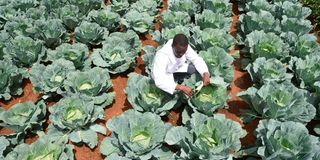Unlock finance and insurance for agriculture

Robert Toroitich, a worker at Uasin Gishu County Government’s Agriculture and Agribusiness department tends to cabbages at their exhibition stand, at the Agricultural Society of Kenya, Eldoret National Show on February 28, 2023.
Agriculture is the mainstay of Kenya’s economy, accounting for a third of GDP and 65 per cent of export earnings.
It employs over 40 per cent of the population and 70 per cent of the rural workforce and provides 18 per cent of formal employment. It is dominated by small-scale production systems (0.2-3 hectares), which account for most of the produce using limited improved inputs and modern production practices.
Largely rain-fed, Kenya’s agriculture is vulnerable to climate change. Floods and drought are more frequent. Drought cycles occur every 2-3 years instead of 5-10. Hence, disaster risk reduction measures are necessary to reduce, prevent and mitigate the significant impact of disasters on the sector. Agricultural growth and productivity depend on food production systems that are resilient against production failure due to shocks and climate variability.
However, financial institutions consider agriculture risky and, consequently, its share of loans remains low (gross loans accounted for only 3.6 per cent of total lending in 2020). The use of credit facilities and investment in the sector would translate to higher resource employment and capacity utilisation, increased output and income for farmers.
The growth and deepening of agriculture finance markets are constrained by factors such as high transaction costs to reach remote rural populations, limited access to funds and technical capacity to assess agriculture risk, absence of adequate instruments to manage risks and low levels of demand due to fragmentation and incipient development of value chains. A significant factor inhibiting financial institutions in the sector is its systemic risk.
System-level approach
There is a need for a system-level approach to managing the challenges and risks of agricultural finance. The government can set up a dedicated well-integrated “de-risking and financing facility” to strengthen policies and schemes built around risk financing, risk management and capacity-building instruments. That would make agricultural finance less risky and incentivise private financial service providers to increase their commitments to smallholder farmers and agri-SMEs.
That’ll guide and align agribusiness development services geared towards crowding in private sector investment; identify challenges to agricultural value chains attaining their full potential and solutions to overcome them; deploy modern agricultural risk management instruments to make farming profitable and income-predictable; and facilitate technical assistance and incentives to actors.
With the Kenya Integrated Agriculture Management Information System launched, ICT solutions can be utilised to lower the cost of financial services and strengthen the efficiency of the value chains. A dedicated and integrated facility serving all value chain players will be key to achieving the much-needed transformation of agriculture and help in transforming the lives of two million poor farmers from a food deficit to surplus production.
Mr Sundeep ([email protected] ) is the CEO Zamara. Mr Ayandev ( [email protected] ) is the lead, Climate Risk Insurance, K.M. Dastur, UK.





